Leeton, New South Wales
Leeton is a town located in the Riverina region of southern New South Wales, Australia. Situated approximately 550 km west of Sydney and 450 km north of Melbourne in the Murrumbidgee Irrigation Area,[2] it is the administrative centre of the Leeton Shire Council local government area. Leeton's urban population in 2016 was 8,623.[1] Situated in one of the most productive farming regions in the state, the town was designed by Walter Burley Griffin and purpose-built for the irrigation schemes announced by the New South Wales government in the early 1900s.[2][3][4] Citrus, rice, cotton, grapes, walnuts and wheat farms can all be found throughout the Leeton Shire. Leeton is renowned as Australia's Rice Capital and as The Heart of SunRice Country, as it is home to the SunRice headquarters.[5][6] Other industry includes Freedom Foods, the Daily Drinks Co., JBS Australia, Webster Limited (walnuts and cotton)[7] and Murrumbidgee Irrigation Limited.[8]
| Leeton New South Wales | |||||||||
|---|---|---|---|---|---|---|---|---|---|
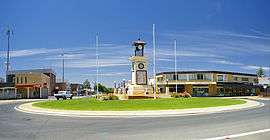 Leeton War Memorial | |||||||||
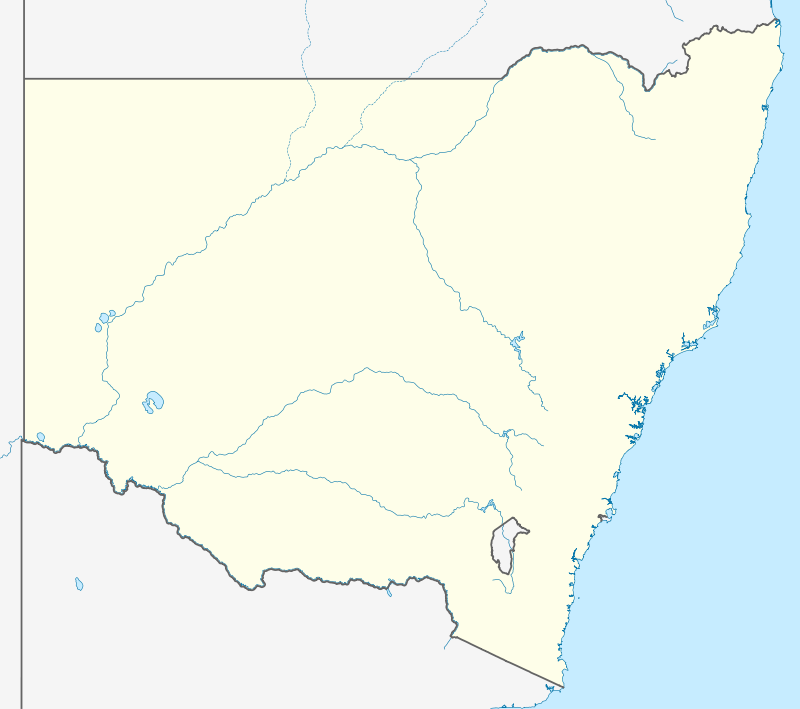 Leeton | |||||||||
| Coordinates | 34°34′0″S 146°24′0″E | ||||||||
| Population | 8,623 (2016 census)[1] | ||||||||
| Established | 2 April 1913 | ||||||||
| Postcode(s) | 2705 | ||||||||
| Elevation | 138.3 m (454 ft) | ||||||||
| Location | |||||||||
| LGA(s) | Leeton Shire | ||||||||
| County | Cooper | ||||||||
| Parish | Willimbong | ||||||||
| State electorate(s) | Murray | ||||||||
| Federal Division(s) | Farrer | ||||||||
| |||||||||
History
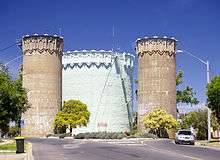
Prior to European settlement, the area was inhabited by the Wiradjuri people. The town is named after Charles Alfred Lee, a Minister for Public Works in New South Wales from 1904 to 1910.[9][10]
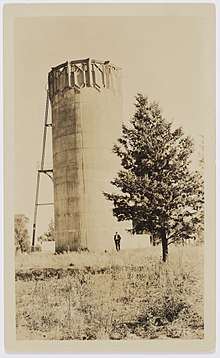
In 1912 a water tower was built to supply water to the then tent town.[11] Leeton Post Office opened on 6 September 1912.[12]
In 1913 when the Water Conservation and Irrigation Commission of New South Wales was formed Leeton was only a canvas town, the only houses being those built on farms by settlers and houses for its officers by the Commission.[13] On 3 April 1913 the first block of land was sold in the town. During 1913 a kurrajong tree which became known as the Pioneers' Tree, was planted as a feature in Kurrajong Avenue, and a butter factory was established in the town.[14]
In 1914 World War I broke out; of the town's population of 2000 people, 200 men were serving in the armed forces making it difficult to maintain the plantings in the irrigation area. During 1914 and 1915 an abattoir and canning factory were established in the town.[14]
In August 1913 Walter Burley Griffin visited the town to complete its design.[11][15]
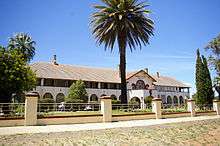
In 1919 the Hydro Hotel was constructed for Water Conservation and Irrigation Commission executives to stay whilst in Leeton but was not licensed to sell alcohol until 1924 when the alcohol prohibition in the Murrumbidgee Irrigation Area was lifted.[16]
During 1920 the Water Conservation and Irrigation Commission of New South Wales began to pressure the Government for relief for being responsible for providing civic and local government services with the Commission stating "revenue which comes mainly from rents and water charges, having remained unchanged, is insufficient to cover the cost of local government services now that the weekly wage is more than double the figure paid when the settlement started".[17] The Commission chose and appointed an Advisory Board which was made up of pioneer farmers which already had been in operation in the Yanco area since 1913. In June 1925 the Commission released its annual report stating that a Royal Commission recommended setting up of local government bodies within the Murrumbidgee Irrigation Area but no date had been decided.[17]
On 1 January 1928 the Willimbong Shire was formed with the name "Willimbong" being retained until 19 July 1946 when it was renamed as Leeton Shire.[18]
In 1929 the Roxy Theatre was built on a large vacant block of land on the corner of Wade and Pine Avenue and was completed and opened in April 1930.[19]
In 1930 Willimbong Shire become the trustee of the Leeton Racecourse, established in 1912, when the land was gazetted as a reserve for racing, public recreation and aviation. In August 1931 Southern Cross became the first aircraft to officially landing at the aerodrome. During 1935 work was done at the aerodrome for it to be licensed to take aircraft including commercial aircraft.[20] In August 1935 Western and Southern Provincial (W.A.S.P.) Airlines commenced an air service between Leeton and Sydney however the service was ended in 1936 when a Tugan Gannet aircraft used by W.A.S.P. Airlines crashed on 26 February 1936 in the Cordeaux Dam area.[20]
In July 1938 it was proposed to the Willimbong Shire by the Civil Aviation Board that an area around Fivebough could be developed into an aerodrome since the Leeton Aerodrome at the race course was too small and could only operate on a restricted licence.[20] Willimbong Shire agreed to lease the land with preliminary work carried out on the site however the aerodrome was never used by any commercial airline.[20]
During World War II, the Royal Australian Air Force established a training school in the nearby town of Narrandera which was a large aerodrome. After this a report from the Department of Civil Aviation stated that Fivebough was eminently suitable as an aerodrome but strongly recommended that they should consider jointly operating the aerodrome with Narrandera Shire.[20]
During the early part of the 1930s Willimbong Shire took over the town water supply when it also became apparent that the town needed a second water tower which was constructed next to the first tower with the construction completed on 27 March 1937.[11]

The Swimming baths in Leeton was constructed by voluntary labour in 1931 and was completed on 24 February 1932.[21] The Leeton Swimming Club made a request that the swimming baths be replaced by a modern swimming complex. In 1959 money was raised though the Irrigana Festival, which was a biennial festival in the town, with the Leeton Shire obtaining a loan with construction starting on the complex.[21] On 17 November 1962 the Leeton & District Memorial Swimming Pool was opened.[21]
Rice growing became a major industry during World War II under Government promotion to help supply food for troops. A number of local farmers, some such as teenager Norm Houghton, pioneered the planting of new varieties to suit the local conditions.[22] The Irrigana Festival began in 1959 as a biennial festival but was short lived due to it lacking strong publicity value even though the festival was successful with fund raising. The name "Irrigana" was chosen from a competition in the Murrumbidgee Irrigator,[23] In 1970 a biennial festival returned in the town known as the "Rice Bowl Festival". By 1988 the festival was renamed to "Sunwhite Rice Festival" with sponsorship from the Ricegrowers Co-Operative Limited.[23]
Heritage listings
Leeton has a number of heritage-listed sites, including:
Education
Leeton is the second largest educational centre in the Riverina after Wagga Wagga.
Leeton Shire has three secondary schools:
Leeton Shire has six primary schools:
- Leeton Public School
- Parkview Public School
- St Joseph's Primary School
- Wamoon Public School
- Yanco Public School
- Whitton Public School
Other education includes:
Climate
Leeton has a semi-arid climate (BSk), with hot dry summers and cool winters.[30][31]
| Climate data for Leeton Caravan Park | |||||||||||||
|---|---|---|---|---|---|---|---|---|---|---|---|---|---|
| Month | Jan | Feb | Mar | Apr | May | Jun | Jul | Aug | Sep | Oct | Nov | Dec | Year |
| Record high °C (°F) | 44.3 (111.7) |
43.9 (111.0) |
38.3 (100.9) |
32.4 (90.3) |
27.2 (81.0) |
28.3 (82.9) |
25.2 (77.4) |
25.0 (77.0) |
33.5 (92.3) |
36.0 (96.8) |
41.4 (106.5) |
42.2 (108.0) |
44.3 (111.7) |
| Average high °C (°F) | 31.9 (89.4) |
31.2 (88.2) |
28.2 (82.8) |
22.9 (73.2) |
18.1 (64.6) |
14.7 (58.5) |
13.9 (57.0) |
15.8 (60.4) |
19.3 (66.7) |
23.0 (73.4) |
27.0 (80.6) |
30.2 (86.4) |
23.0 (73.4) |
| Average low °C (°F) | 17.2 (63.0) |
17.2 (63.0) |
14.6 (58.3) |
10.4 (50.7) |
7.0 (44.6) |
4.6 (40.3) |
3.7 (38.7) |
4.6 (40.3) |
6.6 (43.9) |
9.7 (49.5) |
12.7 (54.9) |
15.6 (60.1) |
10.3 (50.5) |
| Record low °C (°F) | 8.4 (47.1) |
7.8 (46.0) |
3.9 (39.0) |
1.7 (35.1) |
−1.2 (29.8) |
−3.9 (25.0) |
−3.9 (25.0) |
−3.2 (26.2) |
−2.7 (27.1) |
0.6 (33.1) |
4.0 (39.2) |
6.1 (43.0) |
−3.9 (25.0) |
| Average precipitation mm (inches) | 32.4 (1.28) |
30.6 (1.20) |
33.1 (1.30) |
35.0 (1.38) |
39.2 (1.54) |
39.8 (1.57) |
37.1 (1.46) |
40.9 (1.61) |
37.4 (1.47) |
44.7 (1.76) |
30.8 (1.21) |
31.2 (1.23) |
432.3 (17.02) |
| Average rainy days | 4.0 | 3.7 | 4.0 | 5.1 | 7.2 | 8.6 | 9.6 | 9.6 | 7.7 | 7.3 | 5.0 | 4.7 | 76.5 |
| Source: [32] | |||||||||||||
Transport
Leeton is well connected to the surrounding regional centres and capital cities. Leeton is approximately 450 km from Melbourne along the Newell, Goulburn Valley and Hume Highways and 550 km from Sydney along the Sturt and Hume Highways. There are daily flights leaving Narrandera Airport, operated by Regional Express.[33] The airport is located near the shire boundary, approximately 20 km from the CBD. There are coach services to Sydney and Adelaide, leaving Leeton Coach Terminal in Gidgee Street daily. NSW TrainLink also operates coach services to Wagga Wagga connecting with XPT services to Sydney and Melbourne. An Xplorer service to Griffith calls at Leeton railway station on Wednesday and Saturday, with the return service to Sydney calling on Thursday and Sunday.
Industry
The processing of agricultural products comprises Leeton's largest industry.[8] Ricegrowers Limited, operating as SunRice and CopRice, is by far Leeton's largest employer. Its international headquarters are located in the town, as well a rice mill and manufacturing plants. Other major companies includes The Daily Juice Company, JSB Australia (as a subsidiary of JBS S.A.), Murrumbidgee Irrigation Limited, Pacific Fresh,Toorak Wines, Lillypilly Wines and Southern Central Engineering, as well as Freedom Foods, located in Stanbridge and Southern Cotton, located in Whitton.[8][34]
The extensive Vance Industrial Estate houses many smaller scale industrial companies.[35]
Attractions
Leeton has a number of town landmarks, including the Roxy Theatre, War Memorial, Madonna Place, St Peter's Church, and the historic Hydro Motor Inn which are located in the centre of town. The Burley Griffin water towers located on Chelmsford Place are an iconic feature of the town.
Outdoors
The Ramsar-listed Fivebough and Tuckerbil Wetlands as well as the nearby Murrumbidgee River and Murrumbidgee Valley National Park provide ample opportunities for bush-walking and bird-watching.[36][37]
Food and Wine
Restaurants and eateries available in Leeton include The Village Restaurant, Benvenuti Restaurant, Chan's Chinese Restaurant, Crate Cafe, The Coffee Tree, Mick's Bakehouse, Pages on Pine Restaurant and Grill, Leeton Soldiers Club, Henry's Chung Hing Chinese Restaurant, Hotel Leeton, L&D Bowling Club, Wade Hotel, Gaz's BBQ Parlor and La Fresco Cafe.[38]
Leeton is also home to two award-winning wineries, Lillipilly Estate Wines and Toorak Winery. Both wineries use locally grown grapes to create their wine, and each feature a cellar-door where customers can sample and purchase their products. Together, they offer a selection of red and white wines, as well as Botrytis dessert wines and fortified wines.[38][39][40]
Retail
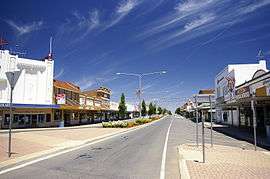
Leeton's main shopping areas include Pine Avenue and Kurrajong Avenue, as well as the town's two shopping complexes, Leeton Market Plaza (opened in 2006)[41] and the Woolworths & Target Complex on Wamoon Avenue.[42][43] Other retailers include: Best & Less,[44] Aldi,[45] The Reject Shop,[46] IGA,[47] EB Games, St. Vincent de Paul's and McDonald's.[48]
Media
Leeton has its own newspaper known as The Irrigator (formerly known as The Murrumbidgee Irrigator) which is released throughout the region on Tuesday and Friday.[6] Leeton also has influences on the Star FM (99.7) and 2RG radio stations which are based in Griffith. WIN Television also broadcasts the local news of the Riverina on weeknights.
Notable citizens
Notable citizens originating from Leeton include former deputy leader of the NSW Labor Party and current federal MP for the NSW seat of Barton Linda Burney, Australian Labor Party Senator John Faulkner;[49] Three time Olympic swimmer (Barcelona 1992, Atlanta 1996, SYDNEY 2000) and Seven times Commonwealth Games Gold Medallist Matthew Dunn;[50] National Rugby League footballer Rod Maybon; professional road bicycle racer Robert McLachlan; National Rugby League footballer and commentator Peter Peters; current National Rugby League players Jeff Robson,[51][52] Clint Halden; former captain of the Australia national cricket team, cricketer and commentator Mark Taylor;[53] consumer advocate Helen Wellings;[54] AFL players Craig Nettelbeck, Max Kruse, Jacob Hopper[55] and Jacob Townsend.[56]
Australian poet and writer Henry Lawson lived in Leeton for two years, from 1916 to 1917. Lawson had been hired to write about the Murrumbidgee Irrigation Area to attract settlers to the area.[57][58]
References
- Australian Bureau of Statistics (27 June 2017). "Leeton LGA". 2016 Census QuickStats. Retrieved 18 December 2018.

- "Leeton". Walkabout. Archived from the original on 20 July 2008. Retrieved 20 March 2008.
- "About the Shire". Leeton Shire Council. Archived from the original on 21 February 2008. Retrieved 20 March 2008.
- "History". Leeton Shire Council. Retrieved 30 May 2018.
- "Fine Food & Wine". Riverina Regional Tourism. Archived from the original on 19 July 2008. Retrieved 28 August 2008.
- "The Irrigator" (PDF). Fairfax Media. Riverina Media Group. Archived from the original (PDF) on 6 July 2011. Retrieved 19 August 2008.
- "Webster Annual Report 2017" (PDF).
- "Industry and Investment". Leeton Shire Council. Retrieved 30 May 2018.
- "Place names". The Australian Women's Weekly. National Library of Australia. 13 May 1964. p. 61. Retrieved 22 February 2011.
- Leeton Tourism: Charles Alfred Lee Archived 18 February 2011 at the Wayback Machine, accessed 22 February 2011.
- Maguire, Marie (1988). Local Government in Leeton 1928–1988. Leeton Shire Council. p. 14. ISBN 0959991611.
- Premier Postal History. "Post Office List". Retrieved 11 June 2009.
- Maguire, Marie (1988). Local Government in Leeton 1928–1988. Leeton Shire Council. p. 7. ISBN 0959991611.
- Maguire, Marie (1988). Local Government in Leeton 1928–1988. Leeton Shire Council. p. 8. ISBN 0959991611.
- Maguire, Marie (1988). Local Government in Leeton 1928–1988. Leeton Shire Council. p. 21. ISBN 0959991611.
- "Leeton". Australian Heritage magazine. Hallmark Editions. Retrieved 7 March 2009.
- Maguire, Marie (1988). Local Government in Leeton 1928–1988. Leeton Shire Council. p. 9. ISBN 0959991611.
- Maguire, Marie (1988). Local Government in Leeton 1928–1988. Leeton Shire Council. p. 10. ISBN 0959991611.
- Maguire, Marie (1988). Local Government in Leeton 1928–1988. Leeton Shire Council. p. 41. ISBN 0959991611.
- Maguire, Marie (1988). Local Government in Leeton 1928–1988. Leeton Shire Council. p. 39. ISBN 0959991611.
- Maguire, Marie (1988). Local Government in Leeton 1928–1988. Leeton Shire Council. p. 35. ISBN 0959991611.
- Peter Lalor, 'Rice growers resent water-wasting image', The Australian, 11 Nov 2006 (registration required)
- Maguire, Marie (1988). Local Government in Leeton 1928–1988. Leeton Shire Council. p. 47. ISBN 0959991611.
- "Hydro Hotel". New South Wales State Heritage Register. Office of Environment and Heritage. H00247. Retrieved 18 May 2018.
- "Koonadan". Office of Environment and Heritage. Retrieved 4 June 2019.
- "Leeton District Lands Office". New South Wales State Heritage Register. Office of Environment and Heritage. H00965. Retrieved 18 May 2018.
- "Leeton District Office - Artefacts in Reception Lobby Showcase 1". New South Wales State Heritage Register. Office of Environment and Heritage. H00966. Retrieved 18 May 2018.
- "Leeton Railway Station and yard group". New South Wales State Heritage Register. Office of Environment and Heritage. H01178. Retrieved 18 May 2018.
- "Roxy Community Theatre". New South Wales State Heritage Register. Office of Environment and Heritage. H01747. Retrieved 18 May 2018.
- "Leeton" (PDF). C Change Bureau. Archived from the original (PDF) on 19 July 2008. Retrieved 2 February 2009.
- "Australian climatic zones". Australian Government. Bureau of Meteorology. Archived from the original on 4 December 2008. Retrieved 21 December 2008.
- "Summary statistics Leeton Caravan Park". Bureau of Meteorology. Commonwealth of Australia. 2 June 2011. Retrieved 5 June 2011.
- "Getting to Leeton". Leeton Shire Council. Retrieved 8 May 2020.
- "Agriculture". Leeton Shire Council. Retrieved 30 May 2018.
- Hopper, Rebecca. "Vance Industrial Estate welcomes NBN". The Irrigator. Retrieved 8 May 2020.
- "Fast Facts". Leeton Shire Council. Retrieved 30 May 2018.
- "Fivebough RAMSAR Wetlands". Leeton Shire Council. Retrieved 30 May 2018.
- "Food and Wine". Leeton Shire Council. Retrieved 31 May 2018.
- "About Us". Toorak Wines. Retrieved 31 May 2018.
- "Our Story". Lillypilly Estate Wines. Retrieved 31 May 2018.
- "Leeton Market Plaza". Open Buildings. Retrieved 9 April 2015.
- "Leeton, NSW". Woolworths Group Limited. Retrieved 31 May 2018.
- "Target Country - Leeton". Westfarmers Ltd. Retrieved 31 May 2018.
- "Best&Less Online". bestandless.com.au.
- "ALDI - Leeton, NSW - Opening Hours & Catalogue". Retrieved 6 May 2020.
- "Leeton - The Reject Shop". rejectshop.com.au. Retrieved 6 May 2020.
- "Golden Apple SUPA IGA". IGA.com.au. Retrieved 8 May 2020.
- "LEETON NSW - McDonald's Australia". McDonald's Australia. Retrieved 6 May 2020.
- "Former Senator the Hon John Faulkner". Parliament of Australia.
- "The WADA Interview - Matthew Dunn". World Anti-Doping Agency.
- "Jeff Robson - Career Stats & Summary - Rugby League Project". Rugby League Project. Retrieved 8 May 2020.
- Ritchie, Dean. "Parramatta turn to Jeff Robson at halfback". The Daily Telegraph. Retrieved 8 May 2020.
- Byrne, Shannon; Coleman, Chris. "Leeton's Mark Taylor inducted into Australia's cricket hall of fame". ABC.net.au. Retrieved 8 May 2020.
- Kent, Simon (19 July 1992). "Helen Wellings "without fear or favour"". The Sydney Morning Herald. Retrieved 6 May 2020.
- Cordy, Neil. "GWS Rising Star Jacob Hopper out of the wilderness and into the AFL spotlight". Daily Telegraph.
- Byrne, Shannon. "Jacob Townsend signs with Team GWS". ABC.net.au.
- "Images of Henry Lawson". University of Sydney Library. 26 May 2011. Archived from the original on 16 June 2011. Retrieved 5 June 2011.
- "Henry Lawson". Leeton Shire Council. Retrieved 17 July 2015.
External links
- Leeton Shire Council – council website
- Leeton Visitors Information Centre
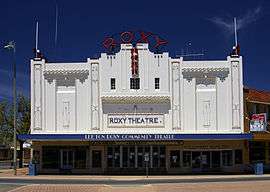
.jpg)